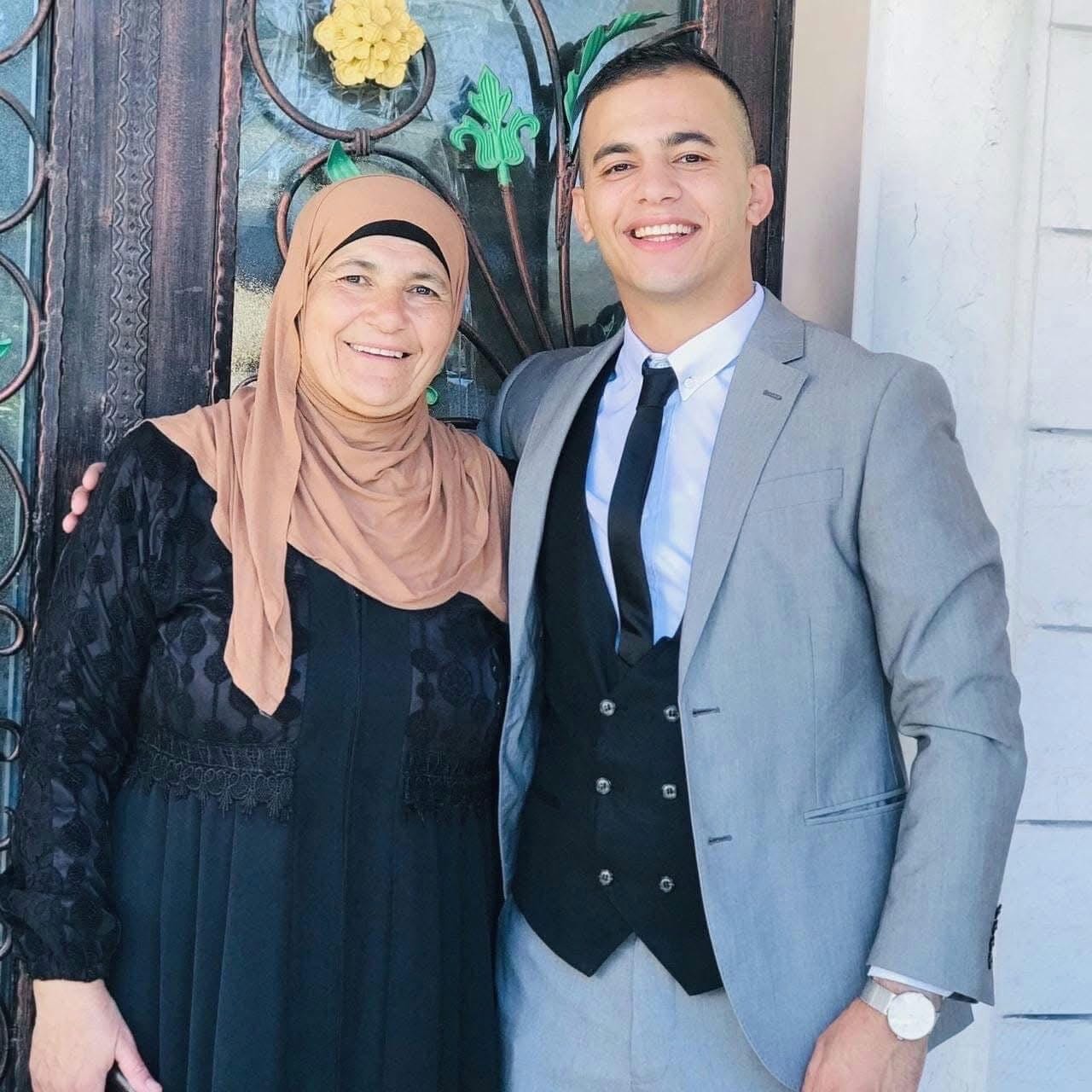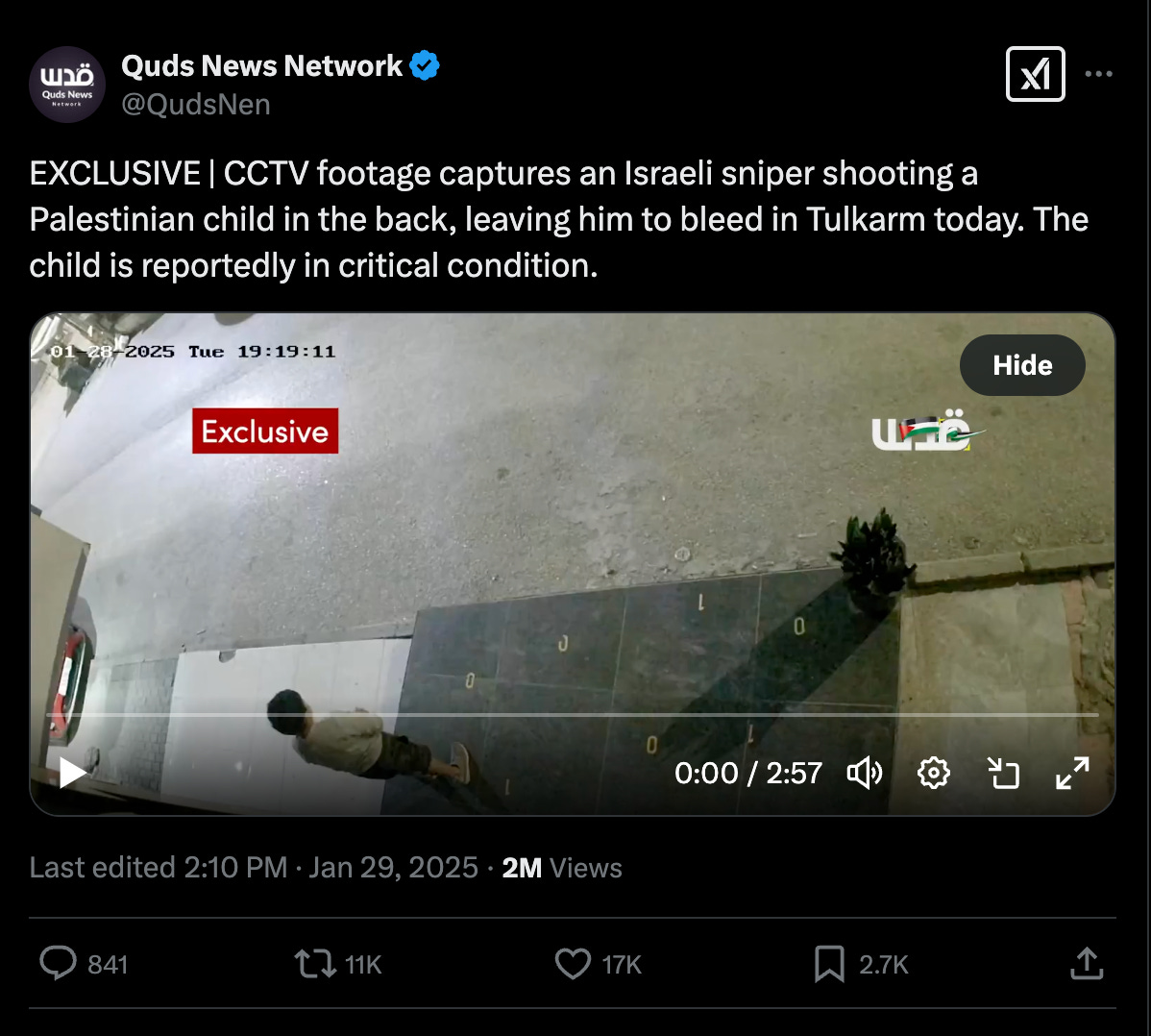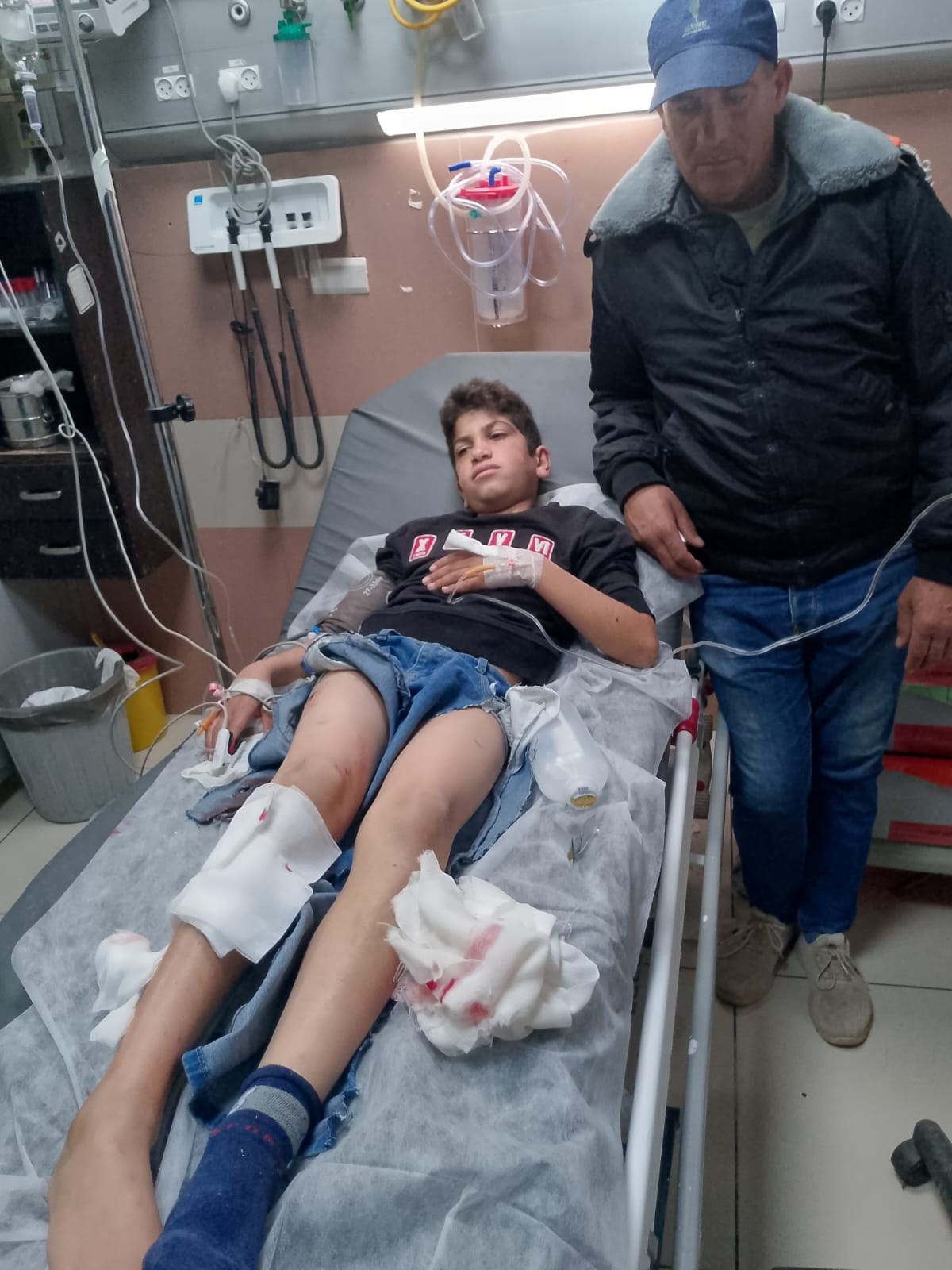
“The sorrow of loving Palestine.”
Three random days in the West Bank.
Please see the original article for the videos and audio files described.
Last week the criminal madman the White House made public his intention to steal the Gaza Strip and turn it into a real estate bonanza for the U.S.-Israeli Zionist empire. Just yesterday, he gave Israel the green light to continue its campaign of genocide saying, “If all hostages aren’t returned by Saturday at twelve o’clock . . . all bets are off and let hell break out.” This followed an announcement by Hamas that it would postpone the release of more hostages because of Israel’s continuous and well-documented violations of the ceasefire agreement.
In the meantime, violence in the West Bank continues to escalate.
As I am among the fortunate who have traveled in Palestine and gotten to know Palestinians—becoming friends with many of the people I have met—I am also now intimately familiar with the joy and pain of loving Palestinians.
It is with this in mind that I offer the following report, presented in a way to bring you as close as possible to the people I know, to the everyday violence in their lives, to the intentional, terror-producing randomness of that violence, and to the heartbreak of loving people who are trapped and trampled by two rogue terrorist states.
As a writer, as opposed to a journalist, I have no need to assume even the pretense of objective distance from the people I write about. This is the perspective I hope to impart: up close, intimate, and fully engaged with the humanity of West Bank Palestinians. It is precisely this perspective I believe we must all have—we in the West—if we are to maintain our own humanity.
■
Updates from the West Bank arrive by text and telephone from people I know and care about, as happened this past Sunday when a series of videos dropped at 8:03 a.m. (North American Central Time Zone) from my friend Ahmad in al–Arroub. The single written text said: “We have a martyr.”
Anyone killed by one of the occupiers—an I.O.F. soldier or terrorist settler—is considered a martyr. This is true whether he or she was part of the armed resistance, a child throwing a rock, an inconvenient poet, or simply someone in the wrong place at the wrong time, which is to say: killed for being Palestinian. And this is regardless of whether a person is Christian or Muslim.
What follows is the sequence in which the details of what transpired were reported by Ahmad. I share the story this way to bring you as close as possible to the experience of those involved—including my own as the person receiving these texts.
The first of Ahmad’s messages was the following video, as shot from where he was standing in al–Arroub when a raid by the I.O.F. was getting under way. In the distance, at the end of the street, an armored vehicle blocks the intersection.
In the next video you hear the sound of gunfire. It was shot inside and appears chaotic, as Ahmad attempts to film through an opaque louvered window while trying to remain safe.
This third video in the initial sequence was accompanied by the text, “We have a martyr.”
On this particular Sunday morning the martyr was Mohammad Hdoosh, a 27-year old resident of al–Arroub refugee camp who worked for the Palestinian Customs Authority after graduating from college. Hdoosh was on his way to a makhbaz, a local bakery, to purchase sweets to distribute to his neighbors and to have on hand for the people who would be stopping by his parent’s home over the next few days to celebrate the good news of his engagement. Mohammad Hdoosh was killed the day after his engagement had been formally announced.
In the above video you see Hdoosh’s father grieving over his son’s body.
This was my first news that morning as I sat down to a breakfast that remained uneaten, as I then began a lengthy text exchange with Ahmad. Below are two audio recordings in which he briefly described what happened. I share them here because there is an intimacy in the human voice that cannot be conveyed in text and because, as you listen, it will be to the voice of someone who knew Hdoosh.
You may wonder about what appears to be a lack of emotion in Ahmad’s voice. A lack of emotional response to traumatic events is typical, I have found, among West Bank Palestinians—a topic I will take up in a later essay. Palestinians do not have time to properly mourn each victim. They do not have the luxury of what we in the West refer to as post-traumatic stress disorder because their trauma is continuous. There has never been an end to the traumatic events that began in their land more than a century ago. What you will hear at the end of this first recording is a long and, I think, anguished sigh—Ahmad’s single display of emotion throughout our exchange that morning.
Here Ahmad tells us about the young man Mohammad Hdoosh. As if compounding the tragedy, Hdoosh had recently returned from Mecca where he had been on a short pilgrimage known as Umrah.
As you will learn in the following, Ahmad, who was more fortunate than Mohammad, was also shot at while he was on the street that day.
Ahmad next sent a recent video of Hdoosh, followed by a photograph of mother and son taken at the formal announcement of his engagement.
He was, as you can see in the photo, immensely happy about his forthcoming marriage.

On the day of Hdoosh’s engagement, his mother posted a photograph to her FaceBook account of her son with a message of congratulations scrawled in Arabic across the top. (This is the photo atop this report.) The English translation reads,
I congratulate my beloved son, Mohammad, and his dear fiancée, Aseel, on reciting al–Fatiha. May God bless you both and bring you together in goodness.
In the hours before he was killed, friends sent messages of congratulation to Mohammad’s mother on FaceBook. They quickly turned into expressions of condolence as news of his death spread. This obscene violence—the rending of Palestinian families and communities—is wanton by design and absolutely routine. It is the intent and fulfillment of the Zionists’ exterminatory policy—with, it must never be forgotten, the full support of the U.S.
I asked Ahmad if the murder of this young man represented an escalation of violence in al–Arroub. He replied as follows:
It is clearly a start of an escalation. Especially as the Israel army is threatening the refugee camps in the West Bank. They keep saying that they are planning on campaigns against all refugee camps. I have no idea what they are [planning] for us but it’s not good. It’s bad.
This guy got shot in the belly today and he died after a few minutes while they were rushing him to the hospital. He was literally doing nothing but standing in the distance and watching the Israeli army raiding the camp. Just like I was standing in front of the armored vehicles, the convoy, and I was filming for you. He was standing at a distance.
And today I actually experienced the feeling of getting shot at. I heard how the bullets were hitting the ground right in front of me and I saw the dust flying around. It was terrifying. I can’t explain how terrifying it was.
■
Two weeks ago on Tuesday, 28 January—five days before Mohammad Hdoosh was murdered—a 10–year-old named Saddam Hussein Iyad Mohammad Rajab was shot in the town of Tulkarem. The boy had been shut inside his house for two days as I.O.F. terrorists occupied his community. When Rajab went briefly outside, he was shot in the back. The shooting, as reported by Defense for Children International–Palestine, was captured on camera.

This incident grew yet more perverse. Zionist forces detained the ambulance as it was transporting the boy to a hospital in Nablus. As reported by DCI–Palestine, “One soldier told Saddam’s father, ‘I am the one who shot your son. God willing, he will die.’”
It is precisely this kind of behavior that successive U.S. administrations have enabled—notably but by no means only via the cynical Oslo accords. Trump’s unhinged statements regarding Gaza, his utter disregard for international law and basic decency, serve only to inflame Zionist violence across the West Bank as settlers and soldiers advance their agenda of annexation and ethnic cleansing. Villages and refugee camps are being systematically targeted in an effort to forcibly drive rural Palestinians into urban areas that have been encircled by settlements and military posts or force them to flee the West Bank altogether.
Al Jazeera reported last Thursday that an estimated 26,000 Palestinians have been displaced in the last two weeks as occupation forces conduct bombing raids and detonate homes in Jenin, Tulkarem, and Nablus. But that is already old news. Just yesterday the UN increased that figure to 40,000 reporting that several refugee camps have been nearly emptied since 21 January when Israel launched Operation Firewall. “What has been happening in Jenin city and the refugee camp over the past two weeks is similar to that of Gaza but on a smaller scale,” the mayor of Jenin, Mohammad Jarrar, told CNN.
It is difficult to keep up with the pace and escalation of Israeli atrocities.
A week ago Monday, some 24 hours after hearing from Ahmad, I received a phone call from a friend in al–Mughayyir, a village of 4,000 located some 60 kilometers north and east of Ramallah. “Marhaba. Hello Kathem,” I said, upon picking up the phone.
“How are you?” Kathem asked in the little English he knows.
“Alhamdulillah, I am good,” was my reply.
He then passed the phone to a relative who speaks English. And that was when I learned that Kathem’s 11–year-old son had been shot. The boy had left the mosque after Asr, the afternoon prayer, and wandered down into the valley to visit his family’s agricultural land—wheat fields, olive groves, and vineyards that were stolen by settlers two years ago. A soldier, seeing the boy, had taken the opportunity to shoot him.
“He was on the road, where you took a picture of Kathem last year.”
I remembered the day well. We had driven down into the fertile valley—thousands of dunams of productive farmland that had belonged to the village. We stopped the car and Kathem asked me to take a picture of him standing in front of his wheat field. It was all he had left of his land—a picture. We hadn’t lingered long.
Kathem’s son was lucky. The shot, almost certainly intended to leave him an amputee, missed the kneecap by millimeters and instead destroyed a chunk of muscle. He is now home from the hospital and will have use of his leg after several months of recovery. Kathem sent me a photo of the wound. It is gruesome, stomach-turning. But it is tame by comparison with what we have seen coming out of Gaza these past many months.

Think of it: Kathem’s son is lucky. Let the full significance of this sink in. This is what passes for luck in Palestine.
■
Ahmad sent me one last video concluding his report on the killing of Mohammad Hdoosh. It was of his funeral procession, which was a striking display of resistance and defiance. In it you see the yellow and green flags of Fatah and Hamas.
Ahmad translated the loud chanting, an expression of pride for the fighters in Gaza. “The Qasami did it again, captured soldiers and freed prisoners.”
Let Mohammad Hdoosh’s funeral procession be a message and warning for Trump, for the mad Zionists who surround him, and for the terrorist Zionist State: Palestinians will not be forced from their land.
There will almost certainly be many more deaths. More children will be shot in the back and legs. There will be more violence, more suffering, and more tears. But one day, from the river to the sea, Palestine will be whole and free.
Inshallah.
This piece appeared previously in West Bank Alerts.
I thank Ahmad, who made much of this report possible, and who took a significant risk in recording the raid as it began.

